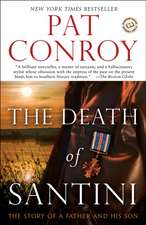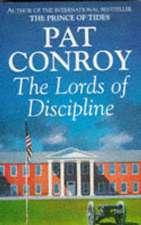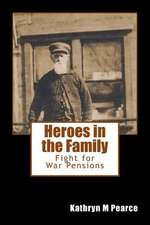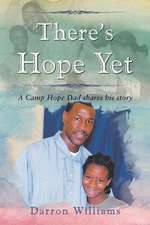The Water Is Wide: A Memoir
Autor Pat Conroyen Limba Engleză Paperback – 28 feb 2002 – vârsta de la 14 până la 18 ani
Here is PAT CONROY’S extraordinary drama based on his own experience–the true story of a man who gave a year of his life to an island and the new life its people gave him.
| Toate formatele și edițiile | Preț | Express |
|---|---|---|
| Paperback (2) | 116.72 lei 3-5 săpt. | |
| Dial Press – 28 feb 2002 | 116.72 lei 3-5 săpt. | |
| Harpercollins – 12 dec 2023 | 155.86 lei 3-5 săpt. |
Preț: 116.72 lei
Nou
Puncte Express: 175
Preț estimativ în valută:
22.34€ • 24.25$ • 18.76£
22.34€ • 24.25$ • 18.76£
Carte disponibilă
Livrare economică 01-15 aprilie
Preluare comenzi: 021 569.72.76
Specificații
ISBN-13: 9780553381573
ISBN-10: 0553381571
Pagini: 320
Dimensiuni: 132 x 208 x 20 mm
Greutate: 0.27 kg
Ediția:Trade PB.
Editura: Dial Press
ISBN-10: 0553381571
Pagini: 320
Dimensiuni: 132 x 208 x 20 mm
Greutate: 0.27 kg
Ediția:Trade PB.
Editura: Dial Press
Notă biografică
Pat Conroy is the bestselling author of The Water is Wide, The Great Santini, The Lords of Discipline, The Prince of Tides, and Beach Music. He lives in Fripp Island, South Carolina.
Extras
Chapter One
The southern school superintendent is a kind of remote deity who breathes the purer air of Mount Parnassus. The teachers see him only on those august occasions when they need to be reminded of the nobility of their calling. The powers of a superintendent are considerable. He hires and fires, manipulates the board of education, handles a staggering amount of money, and maintains the precarious existence of the status quo. Beaufort, South Carolina's superintendent, Dr. Henry Piedmont, had been in Beaufort for only a year when I went to see him. He had a reputation of being tough, capable, and honest. A friend told me that Piedmont took crap from no man.
I walked into his office, introduced myself, chatted briefly, then told him I wanted to teach on Yamacraw Island. He gave me a hard stare and said, "Son, you are a godsend." I sat in the chair rigidly analyzing my new status. "I have prayed at night," he continued, "for an answer to the problems confronting Yamacraw Island. I have worried myself almost sick. And to think you would walk right into my office and offer to teach those poor colored children on that island. It just goes to show you that God works in mysterious ways."
"I don't know if God had anything to do with it, Doctor. I applied for the Peace Corps and haven't heard. Yamacraw seemed like a viable alternative."
"Son, you can do more good at Yamacraw than you could ever do in the Peace Corps. And you would be helping Americans, Pat. And I, for one, think it's very important to help Americans."
"So do I, Doctor."
We chatted on about the problems of the island. Then he said, "You mentioned that God had nothing to do with your decision to go to Yamacraw, Pat. You remind me of myself when I was your age. Of course, I came up the hard way. My folks worked in a mill. Good people, both of them. Simple people, but God-fearing. My mother was a saint. A saint on earth. I worked in the mill, too. Even after I graduated from college, I went back to the mill in a supervisory capacity. But I wasn't happy, Pat. Something was missing. One night I was working late at the mill. I stepped outside the mill and looked up at the stars. I went toward the edge of the forest and fell to my knees. I prayed to Jesus and asked him what he wanted me to do in my life. And do you know what?"
"No, sir, what?"
Then Dr. Piedmont leaned forward in his seat, his eyes transformed with spiritual intensity.
"He told me what to do that very night. He told me, 'Henry, leave the mill. Go into education and help boys to go to college. Help them to be something. Go back to school, Henry, and get an advanced degree.' So I went to Columbia University, one of the great universities of the world. I emerged with a doctorate. I was the first boy from my town who was ever called Doctor."
I added wittily, "That's nice, Doctor."
"You remind me of that boy I was, Pat. Do you know why you came to me today?"
"Yes, sir, I want to teach at Yamacraw."
"No, son. Do you know the real reason?"
"No, sir, I guess I don't."
"Jesus," he said, as if he just found out the stone had been rolled back from the tomb. "You're too young to realize it now, but Jesus made you come to me today."
I left his office soon afterward. He had been impressive. He was a powerful figure, very controlled, almost arrogantly confident in his abilities. He stared at me during our entire conversation. From experience I knew his breed. The mill-town kid who scratched his way to the top. Horatio Alger, who knew how to floor a man with a quick chop to the gonads. He was a product of the upcountry of South Carolina, the Bible Belt, sand-lot baseball, knife fights under the bleachers. His pride in his doctorate was almost religious. It was the badge that told the world that he was no longer a common man. Intellectually, he was a thoroughbred. Financially, he was secure. And Jesus was his backer. Jesus, with the grits-and-gravy voice, the shortstop on the mill team, liked ol' Henry Piedmont.
Yamacraw is an island off the South Carolina mainland not far from Savannah, Georgia. The island is fringed with the green, undulating marshes of the southern coast; shrimp boats ply the waters around her and fishermen cast their lines along her bountiful shores. Deer cut through her forests in small silent herds. The great southern oaks stand broodingly on her banks. The island and the waters around her teem with life. There is something eternal and indestructible about the tide-eroded shores and the dark, threatening silences of the swamps in the heart of the island. Yamacraw is beautiful because man has not yet had time to destroy this beauty.
The twentieth century has basically ignored the presence of Yamacraw. The island is populated with black people who depend on the sea and their small farms for a living. Several white families live on the island in a paternalistic, but in many ways symbiotic, relationship with their neighbors. Only one white family actively participates in island life to any perceptible degree. The other three couples have come to the island to enjoy their retirement in the obscurity of the island's remotest corners. Thus far, no bridge connects the island with the mainland, and anyone who sets foot on the island comes by water. The roads of the island are unpaved and rutted by the passage of ox carts, still a major form of transportation. The hand pump serves up questionable water to the black residents who live in their small familiar houses. Sears, Roebuck catalogues perform their classic function in the crudely built privies, which sit, half-hidden, in the tall grasses behind the shacks. Electricity came to the island several years ago.
There is something unquestionably moving about the line of utility poles coming across the marsh, moving perhaps because electricity is a bringer of miracles and the journey of the faceless utility poles is such a long one--and such a humane one. But there are no telephones (electricity is enough of a miracle for one century). To call the island you must go to the Beaufort Sheriff's Office and talk to the man who works the radio. Otherwise, Yamacraw remains aloof and apart from the world beyond the river.
It is not a large island, nor an important one, but it represents an era and a segment of history that is rapidly dying in America. The people of the island have changed very little since the Emancipation Proclamation. Indeed, many of them have never heard of this proclamation. They love their island with genuine affection but have watched the young people move to the city, to the lands far away and far removed from Yamacraw. The island is dying, and the people know it.
In the parable of Yamacraw there was a time when the black people supported themselves well, worked hard, and lived up to the sacred tenets laid down in the Protestant ethic. Each morning the strong young men would take to their bateaux and search the shores and inlets for the large clusters of oysters, which the women and old men in the factory shucked into large jars. Yamacraw oysters were world famous. An island legend claims that a czar of Russia once ordered Yamacraw oysters for an imperial banquet. The white people propagate this rumor. The blacks, for the most part, would not know a czar from a fiddler crab, but the oysters were good, and the oyster factories operating on the island provided a substantial living for all the people. Everyone worked and everyone made money.
Then a villain appeared. It was an industrial factory situated on a knoll above the Savannah River many miles away from Yamacraw. The villain spewed its excrement into the river, infected the creeks, and as silently as the pull of the tides, the filth crept to the shores of Yamacraw. As every good health inspector knows, the unfortunate consumer who lets an infected oyster slide down his throat is flirting with hepatitis. Someone took samples of the water around Yamacraw, analyzed them under a microscope, and reported the results to the proper officials. Soon after this, little white signs were placed by the oyster banks forbidding anyone to gather the oysters. Ten thousand oysters were now as worthless as grains of sand. No czar would order Yamacraw oysters again. The muddy creatures that had provided the people of the island with a way to keep their families alive were placed under permanent quarantine.
Since a factory is soulless and faceless, it could not be moved to understand the destruction its coming had wrought. When the oysters became contaminated, the island's only industry folded almost immediately. The great migration began. A steady flow of people faced with starvation moved toward the cities. They left in search of jobs. Few cities had any intemperate demand for professional oyster-shuckers, but the people were somehow assimilated. The population of the island diminished considerably. Houses surrendered their tenants to the city and signs of sudden departure were rife in the interiors of deserted homes. Over 300 people left the island. They left reluctantly, but left permanently and returned only on sporadic visits to pay homage to the relatives too old or too stubborn to leave. As the oysters died, so did the people.
My neck has lightened several shades since former times, or at least I like to think it has. My early years, darkened by the shadows and regional superstitions of a bona fide cracker boy, act as a sobering agent during the execrable periods of self-righteousness that I inflict on those around me. Sometimes it is good for me to reflect on the Neanderthal period of my youth, when I rode in the backseat of a '57 Chevrolet along a night-blackened Carolina road hunting for blacks to hit with rotten watermelons tossed from the window of the speeding car, as they walked the shoulder of thin backroads. We called this intrepid form of entertainment "nigger-knocking," and it was great fun during the carnival of blind hatred I participated joyfully in during my first couple of years in high school.
Those were the years when the word nigger felt good to my tongue, for my mother raised her children to say colored and to bow our heads at the spoken name of Jesus. My mother taught that only white trash used the more explosive, more satisfying epithet to describe black people. Nigger possessed the mystery and lure of forbidden fruit and I overused it in the snickering clusters of white friends who helped my growing up.
The early years were nomadic ones. Dad's pursuit of greatness in the Marine Corps carried us into some of the more notable swamplands of the East Coast. I attended Catholic schools with mystical names like the Infant of Prague and the Annunciation, as Dad transferred from Marine base to desolate Marine base, or when we retired to my mother's family home in Atlanta when the nation called my father to war. Mom's people hailed originally from the northeast mountains of Alabama, while Dad's greased the railroad cars in Chicago, but attitudinally they could have used the same sheet at a Klan rally.
I loved the smooth-watered fifties, when I worried about the top-ten tunes and the homecoming queen, when I looked to Elvis for salvation, when the sharp dichotomy between black and white lay fallow and unchallenged, and when the World Series still was the most critical event of the year. The sixties brought this spindly-legged dream to its knees and the fall of the dream buried the joy of that blue-eyed youth forever.
Yet there were days that haunted the decade and presaged the tumultuous changes of the later sixties. By some miracle of chance, I was playing a high school basketball game in Greensboro, North Carolina, on the day that black students entered a dime store for the first nationally significant sit-in demonstration. I was walking past the store on the way to my hotel when I heard the drone of the angry white crowd. Word spread along the street that the niggers were up to something, and a crowd started milling around the store. With rolled-up sleeves and the Brylcreem look of the period, the mob soon became a ludicrous caricature of an entire society. The women had sharp, aquiline noses. I remember that. Everyone was surprised and enraged by the usurpation of this inalienable Caucasian right to park one's ass on a leather stool and drink a Coke. I moved quickly out of the area, following a Conroy law of survival that says that restless mobs have a way of drawing trouble and cops--although the cops would not have bothered me on this day, I realized later. It would be nice to report that this event transformed me into a crusader for civil rights, but it did not. It did very little to me.
I moved to Beaufort, South Carolina, in the early sixties, a town fed by warm salt tides and cooled by mild winds from the sea; a somnolent town built on a high bluff where a river snaked fortuitously. I was tired of moving every year, of changing home and environment with every new set of orders, of uprooting simply because my father was a nomad traveling under a different name and occupation. So we came to Beaufort, a town I grew to love with passion and without apology for its serenity, for its splendidly languid pace, and for its profound and infinite beauty. It was a place of hushed, fragrant gardens, silent streets, and large antebellum houses. My father flew jets in its skies and I went to the local segregated high school, courted the daughter of the Baptist minister, and tried to master the fast break and the quick jump shot. I lived in the security of a town founded in the sixteenth century, but in the world beyond it walked John F. Kennedy, the inexorable movement of black people coming up the road in search of the promised American grail, the television performances of Bull Connor, the snarling dogs, the fire hoses, the smoking names of Montgomery, Columbus, Monroe, and Birmingham.
Having cast my lot with Beaufort, I migrated to college seventy miles up the road. I entered The Citadel, the military college of South Carolina, where for four years I marched to breakfast, saluted my superiors, was awakened by bugles; and continued my worship of the jock, the basketball, and the school fight song, "Dixie." For four years I did not think about the world outside the gates. Myopic and color blind, I could not be a flashy, ascotted pilot like my father, so I opted for teaching and Beaufort.
At graduation I headed back down Highway 17 to begin my life teaching in the same high school that had spewed me forth several years before. But there was a difference this time: the purity of the student body was forever tainted. Thanks to the dastardly progression of law, black students now peppered the snow-white Elysium that once had harbored me.
The southern school superintendent is a kind of remote deity who breathes the purer air of Mount Parnassus. The teachers see him only on those august occasions when they need to be reminded of the nobility of their calling. The powers of a superintendent are considerable. He hires and fires, manipulates the board of education, handles a staggering amount of money, and maintains the precarious existence of the status quo. Beaufort, South Carolina's superintendent, Dr. Henry Piedmont, had been in Beaufort for only a year when I went to see him. He had a reputation of being tough, capable, and honest. A friend told me that Piedmont took crap from no man.
I walked into his office, introduced myself, chatted briefly, then told him I wanted to teach on Yamacraw Island. He gave me a hard stare and said, "Son, you are a godsend." I sat in the chair rigidly analyzing my new status. "I have prayed at night," he continued, "for an answer to the problems confronting Yamacraw Island. I have worried myself almost sick. And to think you would walk right into my office and offer to teach those poor colored children on that island. It just goes to show you that God works in mysterious ways."
"I don't know if God had anything to do with it, Doctor. I applied for the Peace Corps and haven't heard. Yamacraw seemed like a viable alternative."
"Son, you can do more good at Yamacraw than you could ever do in the Peace Corps. And you would be helping Americans, Pat. And I, for one, think it's very important to help Americans."
"So do I, Doctor."
We chatted on about the problems of the island. Then he said, "You mentioned that God had nothing to do with your decision to go to Yamacraw, Pat. You remind me of myself when I was your age. Of course, I came up the hard way. My folks worked in a mill. Good people, both of them. Simple people, but God-fearing. My mother was a saint. A saint on earth. I worked in the mill, too. Even after I graduated from college, I went back to the mill in a supervisory capacity. But I wasn't happy, Pat. Something was missing. One night I was working late at the mill. I stepped outside the mill and looked up at the stars. I went toward the edge of the forest and fell to my knees. I prayed to Jesus and asked him what he wanted me to do in my life. And do you know what?"
"No, sir, what?"
Then Dr. Piedmont leaned forward in his seat, his eyes transformed with spiritual intensity.
"He told me what to do that very night. He told me, 'Henry, leave the mill. Go into education and help boys to go to college. Help them to be something. Go back to school, Henry, and get an advanced degree.' So I went to Columbia University, one of the great universities of the world. I emerged with a doctorate. I was the first boy from my town who was ever called Doctor."
I added wittily, "That's nice, Doctor."
"You remind me of that boy I was, Pat. Do you know why you came to me today?"
"Yes, sir, I want to teach at Yamacraw."
"No, son. Do you know the real reason?"
"No, sir, I guess I don't."
"Jesus," he said, as if he just found out the stone had been rolled back from the tomb. "You're too young to realize it now, but Jesus made you come to me today."
I left his office soon afterward. He had been impressive. He was a powerful figure, very controlled, almost arrogantly confident in his abilities. He stared at me during our entire conversation. From experience I knew his breed. The mill-town kid who scratched his way to the top. Horatio Alger, who knew how to floor a man with a quick chop to the gonads. He was a product of the upcountry of South Carolina, the Bible Belt, sand-lot baseball, knife fights under the bleachers. His pride in his doctorate was almost religious. It was the badge that told the world that he was no longer a common man. Intellectually, he was a thoroughbred. Financially, he was secure. And Jesus was his backer. Jesus, with the grits-and-gravy voice, the shortstop on the mill team, liked ol' Henry Piedmont.
Yamacraw is an island off the South Carolina mainland not far from Savannah, Georgia. The island is fringed with the green, undulating marshes of the southern coast; shrimp boats ply the waters around her and fishermen cast their lines along her bountiful shores. Deer cut through her forests in small silent herds. The great southern oaks stand broodingly on her banks. The island and the waters around her teem with life. There is something eternal and indestructible about the tide-eroded shores and the dark, threatening silences of the swamps in the heart of the island. Yamacraw is beautiful because man has not yet had time to destroy this beauty.
The twentieth century has basically ignored the presence of Yamacraw. The island is populated with black people who depend on the sea and their small farms for a living. Several white families live on the island in a paternalistic, but in many ways symbiotic, relationship with their neighbors. Only one white family actively participates in island life to any perceptible degree. The other three couples have come to the island to enjoy their retirement in the obscurity of the island's remotest corners. Thus far, no bridge connects the island with the mainland, and anyone who sets foot on the island comes by water. The roads of the island are unpaved and rutted by the passage of ox carts, still a major form of transportation. The hand pump serves up questionable water to the black residents who live in their small familiar houses. Sears, Roebuck catalogues perform their classic function in the crudely built privies, which sit, half-hidden, in the tall grasses behind the shacks. Electricity came to the island several years ago.
There is something unquestionably moving about the line of utility poles coming across the marsh, moving perhaps because electricity is a bringer of miracles and the journey of the faceless utility poles is such a long one--and such a humane one. But there are no telephones (electricity is enough of a miracle for one century). To call the island you must go to the Beaufort Sheriff's Office and talk to the man who works the radio. Otherwise, Yamacraw remains aloof and apart from the world beyond the river.
It is not a large island, nor an important one, but it represents an era and a segment of history that is rapidly dying in America. The people of the island have changed very little since the Emancipation Proclamation. Indeed, many of them have never heard of this proclamation. They love their island with genuine affection but have watched the young people move to the city, to the lands far away and far removed from Yamacraw. The island is dying, and the people know it.
In the parable of Yamacraw there was a time when the black people supported themselves well, worked hard, and lived up to the sacred tenets laid down in the Protestant ethic. Each morning the strong young men would take to their bateaux and search the shores and inlets for the large clusters of oysters, which the women and old men in the factory shucked into large jars. Yamacraw oysters were world famous. An island legend claims that a czar of Russia once ordered Yamacraw oysters for an imperial banquet. The white people propagate this rumor. The blacks, for the most part, would not know a czar from a fiddler crab, but the oysters were good, and the oyster factories operating on the island provided a substantial living for all the people. Everyone worked and everyone made money.
Then a villain appeared. It was an industrial factory situated on a knoll above the Savannah River many miles away from Yamacraw. The villain spewed its excrement into the river, infected the creeks, and as silently as the pull of the tides, the filth crept to the shores of Yamacraw. As every good health inspector knows, the unfortunate consumer who lets an infected oyster slide down his throat is flirting with hepatitis. Someone took samples of the water around Yamacraw, analyzed them under a microscope, and reported the results to the proper officials. Soon after this, little white signs were placed by the oyster banks forbidding anyone to gather the oysters. Ten thousand oysters were now as worthless as grains of sand. No czar would order Yamacraw oysters again. The muddy creatures that had provided the people of the island with a way to keep their families alive were placed under permanent quarantine.
Since a factory is soulless and faceless, it could not be moved to understand the destruction its coming had wrought. When the oysters became contaminated, the island's only industry folded almost immediately. The great migration began. A steady flow of people faced with starvation moved toward the cities. They left in search of jobs. Few cities had any intemperate demand for professional oyster-shuckers, but the people were somehow assimilated. The population of the island diminished considerably. Houses surrendered their tenants to the city and signs of sudden departure were rife in the interiors of deserted homes. Over 300 people left the island. They left reluctantly, but left permanently and returned only on sporadic visits to pay homage to the relatives too old or too stubborn to leave. As the oysters died, so did the people.
My neck has lightened several shades since former times, or at least I like to think it has. My early years, darkened by the shadows and regional superstitions of a bona fide cracker boy, act as a sobering agent during the execrable periods of self-righteousness that I inflict on those around me. Sometimes it is good for me to reflect on the Neanderthal period of my youth, when I rode in the backseat of a '57 Chevrolet along a night-blackened Carolina road hunting for blacks to hit with rotten watermelons tossed from the window of the speeding car, as they walked the shoulder of thin backroads. We called this intrepid form of entertainment "nigger-knocking," and it was great fun during the carnival of blind hatred I participated joyfully in during my first couple of years in high school.
Those were the years when the word nigger felt good to my tongue, for my mother raised her children to say colored and to bow our heads at the spoken name of Jesus. My mother taught that only white trash used the more explosive, more satisfying epithet to describe black people. Nigger possessed the mystery and lure of forbidden fruit and I overused it in the snickering clusters of white friends who helped my growing up.
The early years were nomadic ones. Dad's pursuit of greatness in the Marine Corps carried us into some of the more notable swamplands of the East Coast. I attended Catholic schools with mystical names like the Infant of Prague and the Annunciation, as Dad transferred from Marine base to desolate Marine base, or when we retired to my mother's family home in Atlanta when the nation called my father to war. Mom's people hailed originally from the northeast mountains of Alabama, while Dad's greased the railroad cars in Chicago, but attitudinally they could have used the same sheet at a Klan rally.
I loved the smooth-watered fifties, when I worried about the top-ten tunes and the homecoming queen, when I looked to Elvis for salvation, when the sharp dichotomy between black and white lay fallow and unchallenged, and when the World Series still was the most critical event of the year. The sixties brought this spindly-legged dream to its knees and the fall of the dream buried the joy of that blue-eyed youth forever.
Yet there were days that haunted the decade and presaged the tumultuous changes of the later sixties. By some miracle of chance, I was playing a high school basketball game in Greensboro, North Carolina, on the day that black students entered a dime store for the first nationally significant sit-in demonstration. I was walking past the store on the way to my hotel when I heard the drone of the angry white crowd. Word spread along the street that the niggers were up to something, and a crowd started milling around the store. With rolled-up sleeves and the Brylcreem look of the period, the mob soon became a ludicrous caricature of an entire society. The women had sharp, aquiline noses. I remember that. Everyone was surprised and enraged by the usurpation of this inalienable Caucasian right to park one's ass on a leather stool and drink a Coke. I moved quickly out of the area, following a Conroy law of survival that says that restless mobs have a way of drawing trouble and cops--although the cops would not have bothered me on this day, I realized later. It would be nice to report that this event transformed me into a crusader for civil rights, but it did not. It did very little to me.
I moved to Beaufort, South Carolina, in the early sixties, a town fed by warm salt tides and cooled by mild winds from the sea; a somnolent town built on a high bluff where a river snaked fortuitously. I was tired of moving every year, of changing home and environment with every new set of orders, of uprooting simply because my father was a nomad traveling under a different name and occupation. So we came to Beaufort, a town I grew to love with passion and without apology for its serenity, for its splendidly languid pace, and for its profound and infinite beauty. It was a place of hushed, fragrant gardens, silent streets, and large antebellum houses. My father flew jets in its skies and I went to the local segregated high school, courted the daughter of the Baptist minister, and tried to master the fast break and the quick jump shot. I lived in the security of a town founded in the sixteenth century, but in the world beyond it walked John F. Kennedy, the inexorable movement of black people coming up the road in search of the promised American grail, the television performances of Bull Connor, the snarling dogs, the fire hoses, the smoking names of Montgomery, Columbus, Monroe, and Birmingham.
Having cast my lot with Beaufort, I migrated to college seventy miles up the road. I entered The Citadel, the military college of South Carolina, where for four years I marched to breakfast, saluted my superiors, was awakened by bugles; and continued my worship of the jock, the basketball, and the school fight song, "Dixie." For four years I did not think about the world outside the gates. Myopic and color blind, I could not be a flashy, ascotted pilot like my father, so I opted for teaching and Beaufort.
At graduation I headed back down Highway 17 to begin my life teaching in the same high school that had spewed me forth several years before. But there was a difference this time: the purity of the student body was forever tainted. Thanks to the dastardly progression of law, black students now peppered the snow-white Elysium that once had harbored me.
Recenzii
“Reading PAT CONROY is like watching Michelangelo paint the Sistine Chapel.”
–Houston Chronicle
“A hell of a good story.”
–The New York Times
–Houston Chronicle
“A hell of a good story.”
–The New York Times
Descriere
Reissued in trade paper, this is the first-person account of the year spent by the author teaching black children on an impoverished island off the South Carolina coast.















